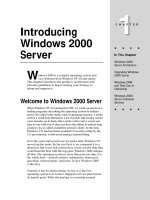Tài liệu HTML5 Mobile Development Cookbook doc
Bạn đang xem bản rút gọn của tài liệu. Xem và tải ngay bản đầy đủ của tài liệu tại đây (7.92 MB, 254 trang )
HTML5 Mobile
Development
Cookbook
Over 60 recipes for building fast, responsive HTML5
mobile websites for iPhone 5, Android, Windows Phone,
and Blackberry
Shi Chuan
BIRMINGHAM - MUMBAI
HTML5 Mobile Development Cookbook
Copyright © 2012 Packt Publishing
All rights reserved. No part of this book may be reproduced, stored in a retrieval system, or
transmitted in any form or by any means, without the prior written permission of the publisher,
except in the case of brief quotations embedded in critical articles or reviews.
Every effort has been made in the preparation of this book to ensure the accuracy of the
information presented. However, the information contained in this book is sold without
warranty, either express or implied. Neither the author, nor Packt Publishing, and its dealers
and distributors will be held liable for any damages caused or alleged to be caused directly
or indirectly by this book.
Packt Publishing has endeavored to provide trademark information about all of the companies
and products mentioned in this book by the appropriate use of capitals. However, Packt
Publishing cannot guarantee the accuracy of this information.
First published: February, 2012
Production Reference: 1240112
Published by Packt Publishing Ltd.
Livery Place
35 Livery Street
Birmingham B3 2PB, UK.
ISBN 978-1-84969-196-3
www.packtpub.com
Cover Image by Rakesh Shejwal ()
Credits
Author
Shi Chuan
Reviewers
Dale Cruse
Sarah Soward
Shawn McBurnie
Acquisition Editor
Alina Lewis
Lead Technical Editor
Shreerang Deshpande
Technical Editor
Sakina Kaydawala
Project Coordinator
Leena Purkait
Proofreader
Bernadette Watkins
Indexer
Monica Ajmera Mehta
Production Coordinator
Prachali Bhiwandkar
Cover Work
Prachali Bhiwandkar
About the Author
Shi Chuan has over ve years experience in web development. He is a member of the
HTML5 Boilerplate project, lead developer of Mobile Boilerplate ( />mobile
), owner of the JavaScript Patterns project ( />javascript-patterns
). He is now an independent developer living in the UK and China.
You can nd out more about him on his personal website at: hub.
com
. He loves reading, travelling, great food, and eclectic and indie music.
I would like to thank my parents, and the whole family who have been my
positive and unconditional supporters. I would also like to thank Jiang Xue,
who taught me so many things about life, in ways she does not even know.
I would also like to thank my friends from the Boilerplate Team - Paul Irish,
Divya Manian, Mathias Bynens, and Nicolas Gallagher. Former CTO of the
company I worked for - Chi Tran. They have been and will always be my
inspiration and aspiration.
About the Reviewers
Dale Cruse, a Boston-area web developer, is the author of HTML5 Multimedia
Development Cookbook
. He has been publishing websites for high-prole clients ranging
from the U.S. Army to Bloomingdale's since 1995. He has been a guest lecturer at the Art
Institute of New England and is currently pursuing speaking opportunities. Contact him at
. He is also the author of the Champagne blog Drinks Are On
Me at .
Sarah Soward teaches coding, design, and the Adobe Creative suite at the Bay Area
Video Coalition and AcademyX. In addition to teaching, she also developed the curriculum for
BAVC's HTML5/CSS3, Color Theory, Typography, Fireworks, and Web Design Workow classes.
For a number of years, she was the Art Director of non-prots. She is the co-author of the
WordPress and Flash Cookbook. When she isn't teaching, she's designing and developing
everything from business cards to websites, painting rhinos, building stuff, and banging on a
drum till her hands keep their own beat. She likes to keep busy.
www.PacktPub.com
Support les, eBooks, discount offers and more
You might want to visit www.PacktPub.com for support les and downloads related to
your book.
Did you know that Packt offers eBook versions of every book published, with PDF and ePub
les available? You can upgrade to the eBook version at
www.PacktPub.com and as a print
book customer, you are entitled to a discount on the eBook copy. Get in touch with us at
for more details.
At www.PacktPub.com, you can also read a collection of free technical articles, sign up
for a range of free newsletters and receive exclusive discounts and offers on Packt books
and eBooks.
Do you need instant solutions to your IT questions? PacktLib is Packt's online digital book
library. Here, you can access, read and search across Packt's entire library of books.
Why Subscribe?
f Fully searchable across every book published by Packt
f Copy and paste, print and bookmark content
f On demand and accessible via web browser
Free Access for Packt account holders
If you have an account with Packt at www.PacktPub.com, you can use this to access
PacktLib today and view nine entirely free books. Simply use your login credentials for
immediate access.
For Claire Jiang Xue
Table of Contents
Preface 1
Chapter 1: HTML5 and the Mobile Web 5
Introduction 5
Setting up mobile development tools 9
BlackBerry simulator 11
Setting up the mobile development environment 13
Using HTML5 on the mobile web 18
Rendering HTML5 across different browsers 20
Designing for mobile 23
Dening a content strategy 31
Chapter 2: Mobile Setup and Optimization 35
Introduction 35
Adding a home screen button icon 36
Preventing text resize 39
Optimizing viewport width 44
Fixing Mobile Safari screen re-ow scale 48
Launching phone-specic programs from the browser 52
Enabling iPhone start screen in full screen mode 56
Prevent iOS from zooming onfocus 58
Disabling or limiting WebKit features 59
Chapter 3: Interactive Media with Mobile Events 63
Introduction 63
Moving an element with touch events 63
Detecting and handling orientation event 66
Rotating an HTML element with gesture events 74
Making a carousel with swipe events 77
Zooming an image with gesture events 82
ii
Table of Contents
Chapter 4: Building Fast and Responsive Websites 85
Introduction 85
Building pages using HTML5 semantics 86
Using CSS3 features for progressive enhancement 89
Applying responsive design 94
Optimizing polylls script loading 97
Applying user agent detection 100
Adding mobile bookmark bubble to the home page 102
Building Contact page with textarea and autogrow forms 104
Making buttons with instant response 106
Hiding WebKit chrome 109
Building a mobile sitemap 112
Chapter 5: Mobile Device Access 115
Introduction 115
Getting your location 116
Handling cross-browser geolocation 119
Displaying a map based on your geolocation 121
Displaying location in realtime 126
Using the DeviceOrientation event 130
Using geolocation with foursquare 134
Chapter 6: Mobile Rich Media 137
Introduction 137
Playing audio on mobile 138
Streaming video on your mobile 142
Using ofine caching 145
Using Web Storage on mobile 148
Using web workers 152
Creating Flash-like navigation with session and history API 157
Chapter 7: Mobile Debugging 163
Introduction 163
Remote debugging with Opera Dragony 163
Remote debugging with weinre 167
Using Firebug on mobile 171
Remote JavaScript debugging with JS Console 174
Setting up Mobile Safari debugging 179
Chapter 8: Server-Side Tuning 187
Introduction 187
Preventing mobile transcoding 188
Adding mobile MIME types 189
iii
Table of Contents
Making cache manifest display properly 191
Setting far future expire headers 191
Compressing les using Gzip 194
Removing ETags 197
Chapter 9: Mobile Performance Testing 201
Introduction 201
Speed testing your device with Blaze 202
Analyzing mobile page speed online 205
Analyzing mobile performance with PCAP Web Performance Analyzer 207
Using HTTP Archive Mobile 209
Storing performance data with Jdrop 211
Chapter 10: Emerging Mobile Web Features 215
Introduction 215
window.onerror 216
Using ECMAScript 5 methods 217
New HTML5 input types 222
Inline SVG in text/HTML 224
position:xed 225
overow:scroll 226
Index 229
Preface
How do I create fast and responsive mobile websites that work across a range of platforms?
For developers dealing with the proliferation of mobile devices each with unique screen sizes
and performance limitations, it is an important question. This cookbook provides the answer.
You will learn how to apply the latest HTML5 mobile web features effectively across a range
of mobile devices.
HTML5 Mobile Development Cookbook will show you how to plan, build, debug, and optimize
mobile websites. Apply the latest HTML5 features that are best for mobile, while discovering
emerging mobile web features to integrate in your mobile sites.
Build a rock-solid default mobile HTML template and understand mobile user interaction.
Make your site fast and responsive, leveraging the uniqueness of location-based mobile
features and mobile rich media. Make your mobile website perfect using debugging,
performance optimization, and server-side tuning. The book nishes with a sneak preview
of future mobile web technologies.
What this book covers
Chapter 1, HTML5 and the Mobile Web, introduces HTML5 and the mobile web, along with
some emulators and simulators.
Chapter 2, Mobile Setup and Optimization, discusses various mobile setups and optimization,
such as preventing text resize and optimizing viewport width.
Chapter 3, Interactive Media with Mobile Events, discusses mobile interactions such as
gesture events.
Chapter 4, Building Fast and Responsive Websites, talks about the various ways to make
mobile websites fast and responsive.
Chapter 5, Mobile Device Access, discusses location-based mobile web and other HTML5
device-specic features.
Preface
2
Chapter 6, Mobile Rich Media, talks about the HTML5 rich media elements that can be
used on mobile browsers.
Chapter 7, Mobile Debugging, teaches you ways to work around mobile screen-side
constraints and debug mobile websites and web apps effectively.
Chapter 8, Server-Side Tuning, focuses on the server-side tuning for mobile websites.
Chapter 9, Mobile Performance Testing, teaches you various Tools and techniques that
can be used to boost mobile performance.
Chapter 10, Emerging Mobile Web Features, talks about ECMAScript 5 as well as mobile-specic
features that were added to allow more functionalities with mobile and boost the performance.
What you need for this book
A text editor is all that is needed for most recipes in the book. You should also have a
mobile device such as an iPhone, Android, Blackberry, or other device suitable for testing.
Although it is best to test things out on a real device, don't worry if you don't have one,
because we will cover details on how to use emulators and simulators to test, in case a
real device is not available.
Who this book is for
Developers keen to create HTML5 mobile websites that are fast and responsive across a
whole range of mobile devices.
Conventions
In this book, you will nd a number of styles of text that distinguish between different kinds of
information. Here are some examples of these styles, and an explanation of their meaning.
Code words in text are shown as follows: "
geolocation is a new property on the
navigator object."
A block of code is set as follows:
var latitude = position.coords.latitude;
var longitude = position.coords.longitude;
var accuracy = position.coords.accuracy;
Preface
3
When we wish to draw your attention to a particular part of a code block, the relevant lines
or items are set in bold:
var latitude = position.coords.latitude;
var longitude = position.coords.longitude;
var accuracy = position.coords.accuracy;
New terms and important words are shown in bold. Words that you see on the screen, in
menus or dialog boxes for example, appear in the text like this: "Click on the Start button
in the Capture Options dialog to start capturing."
Warnings or important notes appear in a box like this.
Tips and tricks appear like this.
Reader feedback
Feedback from our readers is always welcome. Let us know what you think about this
book—what you liked or may have disliked. Reader feedback is important for us to develop
titles that you really get the most out of.
To send us general feedback, simply send an e-mail to , and
mention the book title via the subject of your message.
If there is a book that you need and would like to see us publish, please send us a note in
the SUGGEST A TITLE form on www.packtpub.com or e-mail
If there is a topic that you have expertise in and you are interested in either writing or
contributing to a book, see our author guide on www.packtpub.com/authors.
Customer support
Now that you are the proud owner of a Packt book, we have a number of things to help you
to get the most from your purchase.
Preface
4
Downloading the example code for this book
You can download the example code les for all Packt books you have purchased from your
account at . If you purchased this book elsewhere, you can
visit and register to have the les e-mailed directly
to you.
Errata
Although we have taken every care to ensure the accuracy of our content, mistakes
do happen. If you nd a mistake in one of our books—maybe a mistake in the text or the
code—we would be grateful if you would report this to us. By doing so, you can save other
readers from frustration and help us improve subsequent versions of this book. If you
nd any errata, please report them by visiting
selecting your book, clicking on the errata submission form link, and entering the details
of your errata. Once your errata are veried, your submission will be accepted and the
errata will be uploaded on our website, or added to any list of existing errata, under the
Errata section of that title. Any existing errata can be viewed by selecting your title from
/>Piracy
Piracy of copyright material on the Internet is an ongoing problem across all media. At Packt,
we take the protection of our copyright and licenses very seriously. If you come across any
illegal copies of our works, in any form, on the Internet, please provide us with the location
address or website name immediately so that we can pursue a remedy.
Please contact us at with a link to the suspected pirated material.
We appreciate your help in protecting our authors, and our ability to bring you valuable content.
Questions
You can contact us at if you are having a problem with any
aspect of the book, and we will do our best to address it.
1
HTML5 and
the Mobile Web
In this chapter, we will cover:
f Getting your mobile device ready
f Emulators and simulators
f Setting up the mobile development environment
f Using HTML5 on mobile web
f Making HTML5 render cross browser
f Designing for mobile
f Determining your target mobile devices
f Dening a content adaptation strategy
Introduction
Both HTML5 and mobile web are promising technologies. Both have relatively short histories.
In this chapter, most topics we will be covering are relatively basic. This is to help you get
started with mobile development quickly and with minimum effort.
Both mobile and HTML5 are still evolving in nature and there could be many questions in
your mind. We will clear those doubts and set your mind focused on things that matter.
HTML5 and the Mobile Web
6
The mobile web is growing fast. We now have mobile Safari which is one of the most used apps
on the iPhone, allowing developers to build high performance web applications and enhancing
users' browsing experience. You do not need a developer account to host and run a mobile
site, you don't need to get approval from any app market to launch a mobile website and you
can make updates any time you like without the hassle of waiting for approval. All these are
benets of mobile web development, but at the same time, there are challenges such as
inconsistencies among browsers, the lack of certain features compared to native apps, and
security. We can't tackle them all, but we sure can solve some of them. And we will see, when
developing a mobile site, how we can separate the common practices from the best practices.
There are literally thousands of smartphones out there; you don't need every single one of
them to test your application on. In fact, you may need fewer than 10. If that's still out of your
budget, then two devices are good enough. For the rest, you can use simulators/emulators to
do the job. This book focuses on six A-grade mobile devices, with focus specically on iPhone,
Android, and Windows Phone:
f iOS
f Android
f Windows Mobile
f Blackberry v6.0 and above
f Symbian 60
f Palm webOS
There are two browsers that are device-independent that will also be covered in this book.
They are:
f Opera Mobile
f Firefox Mobile
Just because other browsers are not in the list does not mean they won't be covered by the
issues and techniques we discuss in this book.
Identifying your target mobile devices
Target browser: all
You can't possibly make a mobile site for every single mobile device. No one has the time
or energy to do so.
Cross-browser mobile web development can be crazy. It's hard to dene the scope of the
work, as John Resig (creator of jQuery Mobile) pointed out in his presentation slide
describing his experience building jQuery Mobile ( />jeresig/testing-mobile-javascript
), he asked three questions:
Chapter 1
7
f Which platforms and browsers are popular?
f Which browsers are capable of supporting modern scripting?
f What devices and simulators do I acquire to test with?
When you are building a mobile site, you have to ask yourself similar questions, but not the
exact same questions, because remember your site should be specically tailored to your
target audience. So your questions should be:
f Which platforms and browsers are most commonly used by visitors on my website?
f How many people access my website from a mobile device that is capable of
supporting modern scripting?
f Which devices and simulators do I need for testing?
Which platforms and browsers are most commonly used by
visitors on my website?
Now let's answer the rst question. Before building a mobile website, you must rst nd out
who are your target audience, and what mobile devices they use when visiting your site. There
are many analytics tools that can help you answer these questions. One of those is Google
Analytics. You can sign up for a free Google Analytics account at: gle.
com/analytics/
The way to do it is fairly straightforward: most developers are no strangers to Google Analytics.
All you have to do is to include the JavaScript snippet from the the Google Analytics site and
embed it in your web pages.
JavaScript can be rendered in most modern smartphones, so there is really no difference
between using it on a desktop site and on a mobile site.
How many people access my website from a mobile device that
is capable of supporting modern scripting?
Now let's answer the second question. One thing you may want to nd out is the number
of people using mobile browsers to surf your site. And you also want to nd out how many
people use a relic mobile browser that doesn't support JavaScript at all. This is because if the
percentage of people using low-end smartphones is higher than that of people using high-end
smartphones, it may not be worthwhile using HTML5 in the rst place (although the chance of
this is very low).
So if your goal is not just to know the number of people using smartphones, but also the
number of people who use older versions of mobile phones, Google Analytics for mobile
comes to the rescue. You can download the script from:
/>Google_Analytics_server_side_package
HTML5 and the Mobile Web
8
Google Analytics for mobile server-side packages currently supports JSP, ASPX, Perl, and PHP.
Let's take a look at one of the examples in PHP. All you have to do is to change the ACCOUNT
ID GOES HERE with your GA account ID. But remember to replace 'UA-xx' with 'MO-xx'.
Unfortunately, when you use the server-side version, you can't use it on pages where you also
use the standard JavaScript tracking code,
ga.js. Using the server-side version means that
you have to give up the JavaScript version. It can be annoying because the JavaScript version
provides a lot of dynamic tracking mechanisms that are lacking in the server-side version:
<?php
// Copyright 2009 Google Inc. All Rights Reserved.
$GA_ACCOUNT = "ACCOUNT ID GOES HERE";
$GA_PIXEL = "ga.php";
function googleAnalyticsGetImageUrl() {
global $GA_ACCOUNT, $GA_PIXEL;
$url = "";
$url .= $GA_PIXEL . "?";
$url .= "utmac=" . $GA_ACCOUNT;
$url .= "&utmn=" . rand(0, 0x7fffffff);
$referer = $_SERVER["HTTP_REFERER"];
$query = $_SERVER["QUERY_STRING"];
$path = $_SERVER["REQUEST_URI"];
if (empty($referer)) {
$referer = "-";
}
$url .= "&utmr=" . urlencode($referer);
if (!empty($path)) {
$url .= "&utmp=" . urlencode($path);
}
$url .= "&guid=ON";
return $url;
}
?>
Chapter 1
9
Alternatives to Google Analytics
Google Analytics is not the only mobile analytics service in the market. There are other
services providing more specialized services. For example, PercentMobile is a hosted mobile
analytics service that makes your mobile audience and opportunities clear. You can nd out
more about this service at:
/>Accuracy of Google Analytics
The location reported by mobile devices may not always be accurate; Google Analytics uses
IP addresses to determine user location for Map Overlay reports. They are subject to possible
inaccuracy, as mobile IPs originate from the wireless carrier gateway which is not necessarily
co-located with mobile users.
Server loading speed concern
Due to the server-side processing, some additional server load may be incurred. Google
recommends you rst test the snippet on a few of your pages to ensure all is well before
rolling out to an entire site.
Setting up mobile development tools
Target browser: all
Now one question still remains unanswered from the previous recipe: which devices and
simulators do I need for testing? We will nd this out in this chapter.
If you have gured out what major mobile devices you are going to support, now is the time
to see how to set them up. Mobile development can be costly if you test on various mobile
devices. Although we have all these mobile simulators and emulators available for testing,
it's not as good as testing on a real device. Now let's see how we can maximize the testing
coverage and minimize the cost.
Getting ready
We are going to make some assumptions here. Each case is different, but the idea is the
same. Let's assume you have a Windows operating system on your desktop, but the top
visitors to your site surf using iOS, Android, and Blackberry.
HTML5 and the Mobile Web
10
How to do it
Your goal is to maximize the coverage and minimize the cost. All three devices have
emulators, but not all support different platforms.
Name Compatibility
iOS simulator Mac
Android emulator Windows, Mac, Linux
Blackberry simulator Windows
As you can see, since iOS simulator only works for Mac, and if you are running a Windows
OS, the best and only choice is to purchase an iPhone for testing. For Android and
Blackberry, because they both have emulators for Windows, to save budget, you can
download the emulators.
How it works
1. List the top mobile devices people use to surf your site.
2. Know the machine OS you are using for the development.
3. Find out the compatibility of each of these device emulators to your
development environment.
There's more
If you have the budget for more than one mobile device having a different OS, you can
think further about screen sizes and the DPI of the mobile device. You may not need to buy
two high-end devices. For instance, it's not necessary to own an iPhone4 and an Android
Thunderbolt. You can buy a lower-end of Android just to test out how your site would look
on a lower-end device. So the idea is to combine your OS, mobile devices, and emulators to
maximize the scenarios to cover.
Device simulator/emulator download lookup table
The following table shows a list of popular mobile device emulators for mobile web design
and development testing:
Name Type Compatibility URL
iOS Simulator Mac
le.
com/devcenter/ios/index.
action#downloads
Android Emulator Mac, Win, Linux
/>sdk/index.html









